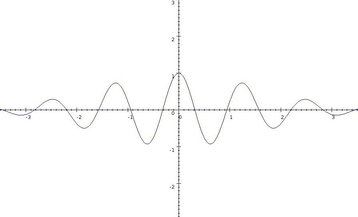Extrema
 From Conservapedia
From Conservapedia Maxima and minima are a type of extrema or critical points (numbers) for functions, which can be found with calculus.
The absolute maximum of a function is the point in the domain at which the function achieves its largest value. For example, the absolute maximum of  occurs at
occurs at  , where
, where  .
A useful fact from calculus is that the maximum of a function on an interval is either its value at an end point or its value when its first derivative is zero and its second derivative is less than zero.
.
A useful fact from calculus is that the maximum of a function on an interval is either its value at an end point or its value when its first derivative is zero and its second derivative is less than zero.
The relative maximum of a function is a point which at which the function takes on its largest value on some neighborhood of the point, i.e., the function takes on smaller values at all sufficiently close points. For example, the function  has many relative maxima, and a unique absolute maximum at
has many relative maxima, and a unique absolute maximum at  . A relative maximum of a function can occur when its first derivative is zero and its second derivative is less than zero or, alternatively, its first derivative is positive approaching the point from the left and negative to its right.
. A relative maximum of a function can occur when its first derivative is zero and its second derivative is less than zero or, alternatively, its first derivative is positive approaching the point from the left and negative to its right.

To find the maxima of multi-variable functions, take the partial derivatives of the function with respect to each variable and set each of those resulting equations to zero.
The minima of a function can be calculated in an analogous manner.
The computation of maxima of functions remains an important issue in more advanced mathematics. For example, it is often useful to consider real-valued continuous functions on more exotic topological spaces, and ask what their maxima are. Note that some functions do not have maxima: for example,  takes on arbitrarily large values. A fundamental theorem states that any function defined on a compact space obtains a maximum value; this is just a consequence of the fact that the image of a compact space under a continuous function is compact, and thus bounded.
takes on arbitrarily large values. A fundamental theorem states that any function defined on a compact space obtains a maximum value; this is just a consequence of the fact that the image of a compact space under a continuous function is compact, and thus bounded.
A simple example of this distinction is the following: one can define a function on the surface of the earth, whose value at a point is the current temperature at that point. One could similarly define such a function on the entire universe, sending a location to its temperature. Since the earth is compact, it follows that there is some point on earth which is the hottest at any given time. However, if the universe is unbounded, it is not compact, and we can not reach the same conclusion! There may be points in the universe which have arbitrarily large temperatures, so that the function has no maximum.
Problem Solving Methodology[edit]
Given a function f(x,y) and asked to find its maxima and minima over a domain defined by a function g(x,y) < c, you would solve this as follows:
- first, set the partial derivatives for f(x,y) equal to zero and find solution pairs in terms of (x,y).
- second, find the endpoint (boundary) values for (x,y) on the domain.
- third, solve the simultaneous equations for f(x,y) and the boundary for g(x,y)=c and set the partial derivatives for that equal to zero to find the solution pairs in terms of (x,y).
- fourth, plug in the various critical points for (x,y) back into f(x,y) and simply identify the absolute and relative maxima and minima.
Categories: [Calculus] [Mathematics]
↧ Download as ZWI file | Last modified: 02/10/2023 15:28:16 | 17 views
☰ Source: https://www.conservapedia.com/Extrema | License: CC BY-SA 3.0
 ZWI signed:
ZWI signed: KSF
KSF